Game Designers: Michael Hayashi, Carina Ly, Caroline Gao
Overview:
BULLY! is a game that utilizes players’ bluffing and social deception skills to raise awareness about bullying. Players are part of a classroom, and there are bullies among the classmates seeking to ruin various friend dynamics. Anyone can be a bully, so players must spot when bullying occurs and effectively intervene. Specifically, in BULLY!, everyone is either a friend or a bully character, but each person’s role is a secret to everyone else. It’s up to the friends to take down the inconspicuous bullies by identifying who the bullies are and by sharing specific, personal actions they would take in reaction to various types of bullying. It’s the bullies’ job to conceal their identity from the friends.
BULLY! has fellowship, discovery, and narrative as the main types of fun. The game is fellowship-oriented because it brings players together and facilitates meaningful interactions among them – cards include questions that relate to real-life bullying situations and encourages personal discussion on how each player would respond, friend characters seek to find each other and stick up for one another, and same with the bullies, and discussion time is integrated after every round. BULLY! has discovery because players are learning about various types of bullying: social, physical, or verbal, and the many ways to intervene. Finally, because BULLY! requires accusation, defense, and storytelling, BULLY! also includes narrative.
BULLY! was inspired by interest in social deception games such as Secret Hitler, Mafia, and Werewolf; however, we wanted to add an educational aspect. We decided to incorporate bullying because, unfortunately, bullying will always be a prevalent issue – around 22% of middle school students and high schoolers experience some type of bullying in their educational careers. Additionally, close to 55% of students have reported being a bystander in a bullying situation because they did not know how to intervene. In BULLY!, each bully action card / bullying situation is unique and falls under one of three categories: verbal, social, or physical bullying, and within each of these classifications, each dilemma touches upon a nuance in bullying that’s not always easy to identify or simple to stand up against. Players will listen and learn from others sharing specific, personal ways they would stand up to bullying, and players will practice standing up to their own situations, too.
Packaging:
High-quality Figma
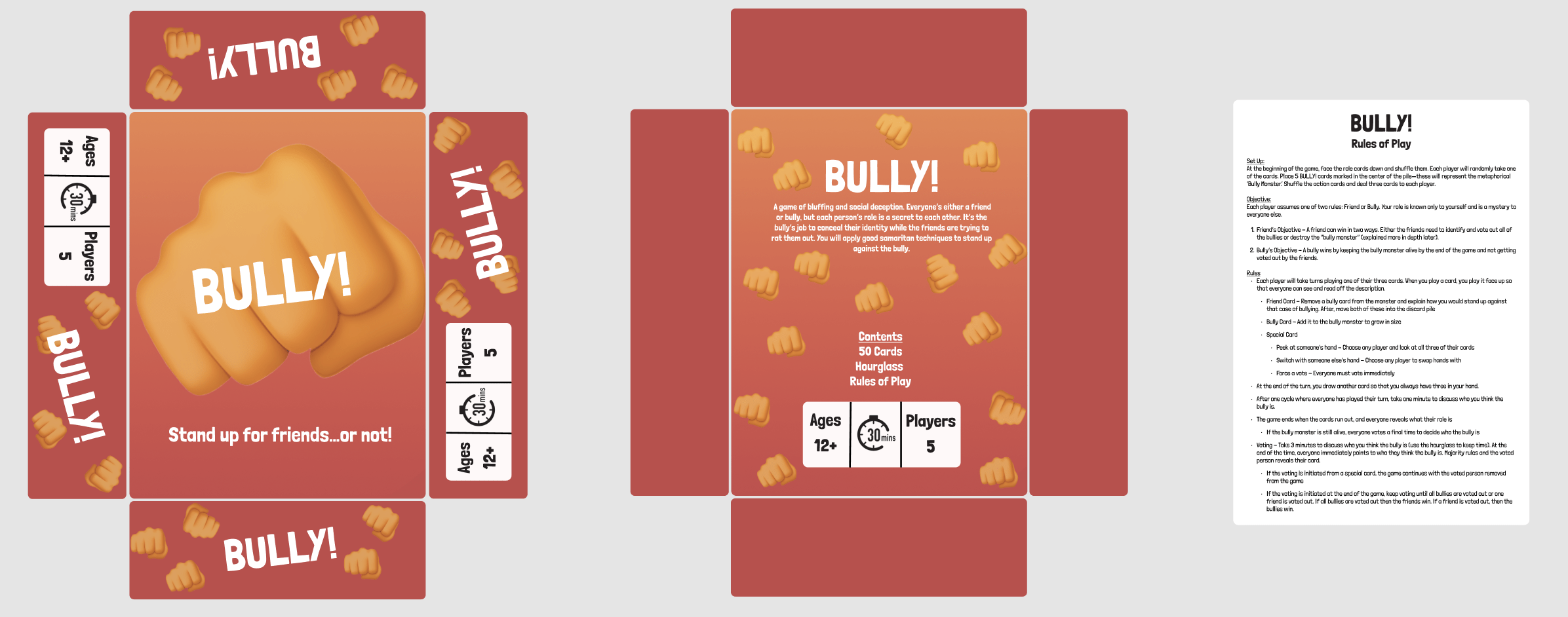
Rules:
Number of Players: 5 (3 Friends, 2 Bullies), ages 12+
Story Background:
BULLY! is a game that utilizes players’ bluffing and social deception skills to raise awareness about bullying. Players are part of a classroom, and there are bullies among the classmates seeking to ruin various friend dynamics. Anyone can be a bully, so players must spot when bullying occurs and effectively intervene. Specifically, in BULLY!, everyone is either a friend or a bully character, but each person’s role is a secret to everyone else. It’s up to the friends to take down the bullies by identifying who the bullies are and by sharing specific, personal actions they would take in reaction to various types of bullying. It’s the bullies’ job to conceal their identity from the friends.
Set Up:
At the beginning of the game, face the role cards down and shuffle them. Each player will randomly take one of the cards. Place 5 bully action cards, facing up, in the center of all the players—this pile of cards will represent the metaphorical “bully monster.” Shuffle the remaining action cards and deal three cards to each player.
Objective:
Each player assumes one of two roles: Friend or Bully. Your role is known only to yourself and is a mystery to everyone else.
- Friend’s Objective: A friend can win in two ways. Either the friends need to identify and vote out all of the bullies, or the friends destroy the bully monster by taking cards out from the center pile (explained more in-depth later).
- Bully’s Objective: A bully wins by keeping the bully monster alive until the end of the game and by not getting voted out by the friends.
Rules:
- Each player will take turns playing one of their three cards. When you play a card, you play it face up so that everyone can see and read off the description.
-
-
- Friend Card: Remove a bully card from the center pile and explain how you would stand up against that case of bullying. After, move both of these cards into the discard pile.
- Bully Card: Add it to the center pile to “grow” the bully monster.
- Special Card:
-
-
-
- Peek at someone’s hand – choose any player and look at all three of their cards.
- Switch with someone’s hand – choose any player to swap hands with.
- Force a vote – everyone must vote immediately.
-
-
-
-
-
- At the end of your turn, draw another card so you always have three cards in your hand.
- After one cycle, where everyone has played their turn, discuss who you think the bully is.
- The game ends when the cards run out. If the bully monster is still alive, everyone votes a final time in an attempt to vote out the bullies.
- Voting: Take up to 3 minutes to discuss who you think the bully is; use the hourglass to keep time. At the end of the time, everyone immediately points to who they think the bully is. The majority rules and the voted person reveals their card.
-
-
- If the voting is initiated from a special card, the game continues with the voted person removed from the game.
- If the voting is initiated at the end of the game, keep voting until all bullies are voted out or one friend is voted out. If all bullies are voted out, the friends win. If a friend is voted out, the bullies win.
-
-
Game Bits:
High-quality Figma
- 50 Cards total
- 40 Action Cards (15 Friend Cards, 25 Bully Cards)
- 5 Role Cards (3 Friends, 2 Bullies)
- 5 Special Cards (2 Peek Cards, 2 Switch Cards, 1 Vote Card)
- Hourglass (3 minutes)
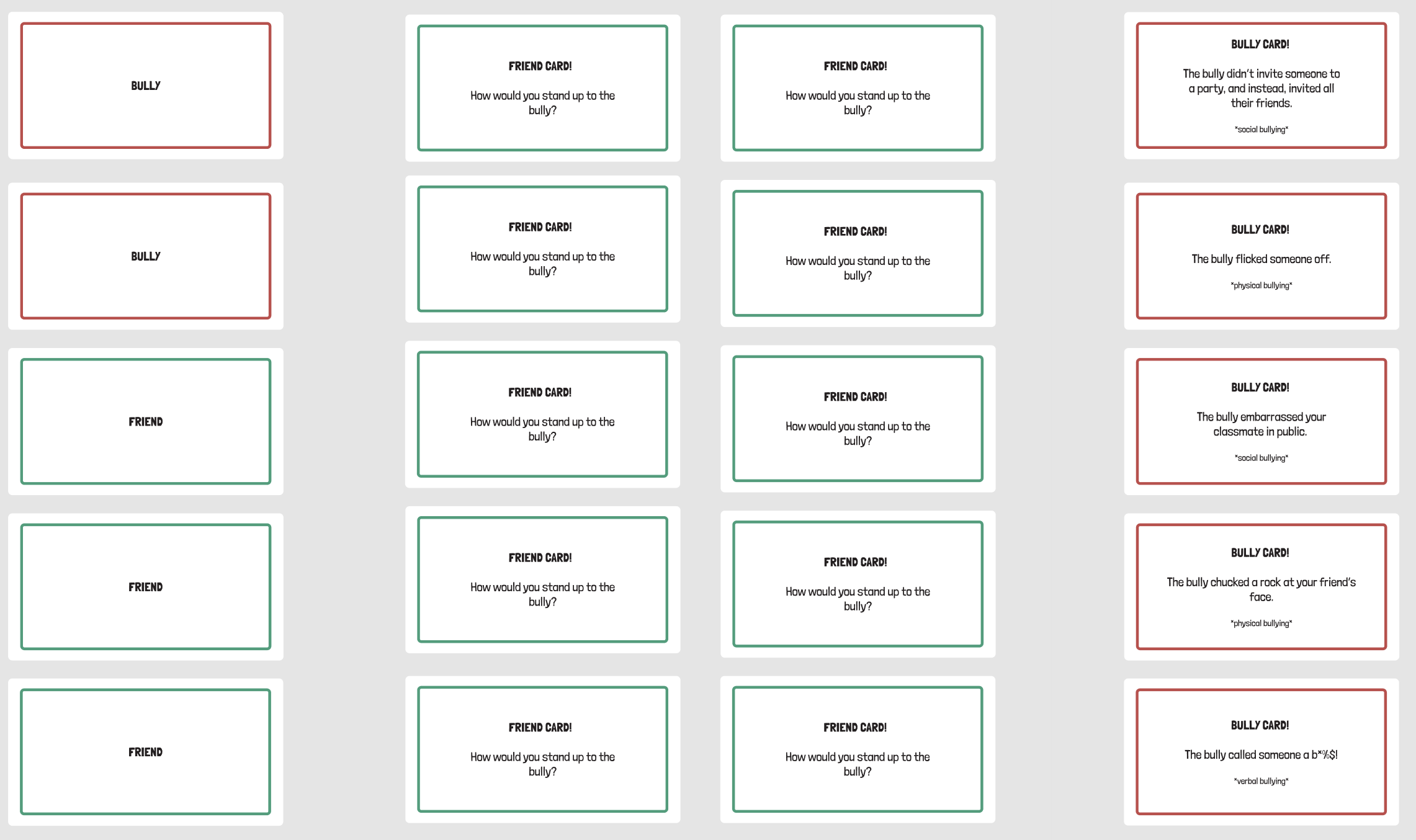
Assessment:
Our game strived to achieve three different assessment goals related to raising awareness about bullying: 1) Are players identifying new modes of bullying that they weren’t previously exposed to before? 2) Are players gaining effective practice in standing up against bullying? Finally, 3) Are players engaging in thoughtful discourse to logically deduce the bully to achieve the game’s objective? We measured these results through observational playtests and post-playtest questions.
During the game, we noticed comments on the concept of the game and minutiae on mechanics, in addition to body language, laughter, and overall engagement. The friend characters were able to share specific, personal actions they would take in reaction to various types of bullying. Evaluating the content of the game, we measured the quality of bullying situations based on noise level and reaction from the group. Assessing the modality of social deception, we paid attention to how keen players were to leveraging game mechanics and using logical deduction to accuse other players of being the bully. The mechanics of our game, specifically the friend action card, really exposes players to various types of bullying and allows them to practice how they would stand up to bullies.
After the session, we inquired on qualitative questions on experiences about the game. We asked about overall response to the game, enjoyment of playing, and any additional feedback. Note that testers’ responses may bias towards more positive because of response bias and lack of anonymity.
After the playtest, we discovered that players enjoyed the bluffing mechanic of the game as they compared it to other social deception games like Among Us and Avalon. Throughout the game, they laughed at the prompts on the cards as well as when players used logic to deduce the true bullies. However, in their feedback, they revealed that some cards were difficult to respond to because some were too light-hearted. Assessing our goals, players learned about new bullying situations, but they struggled with standing up in certain situations.
History:
Playtest 1:
-
-
-
- 5 Players:
-
-
- Alejandro (22, M)
- Kyle (21, M)
- Isabelle (22, F)
- Daniel (28, M)
- Ada (24, F)
-
-
- Observations:
-
-
- Nice balance between good / bad cards; Friends were occasionally forced into playing a bad card
- Added a mid-game mod to provide players with time to discuss, after each round, to determine (and potentially vote on) who the bullies are; passionate discussions / accusations and players defending roles
- Some confusion about all the possible ways to win (get rid of the center bully monster, correctly vote out the 2 bullies, etc.)
-
-
- Changes made after:
-
-
- Because there was no discussion at first, we added time for players to discuss who the potential bullies are:
-
-
- At the end of each cycle
- Added in a new “force vote” card
-
-
- Because there was confusion voting, we decided when voting, if you tie, the vote doesn’t count and you have to continue playing:
-
-
- Vote one bully out at a time
- Simultaneously point to vote
-
-
- To add challenge, we introduced “special power” cards:
-
-
- Players can see another player’s deck
- Exchange hands with another player
- Force a vote
-
-
- To better reach our learning goals / objectives, we decided when playing a friend card, players must respond specifically to the bully card situation that they are removing from the bully monster
- We printed formal playing cards, on thicker cardstock paper, for future playtests. We re-named good / bad cards to friend / bully cards.
- Because there was no discussion at first, we added time for players to discuss who the potential bullies are:
-
-
- 5 Players:
-
-
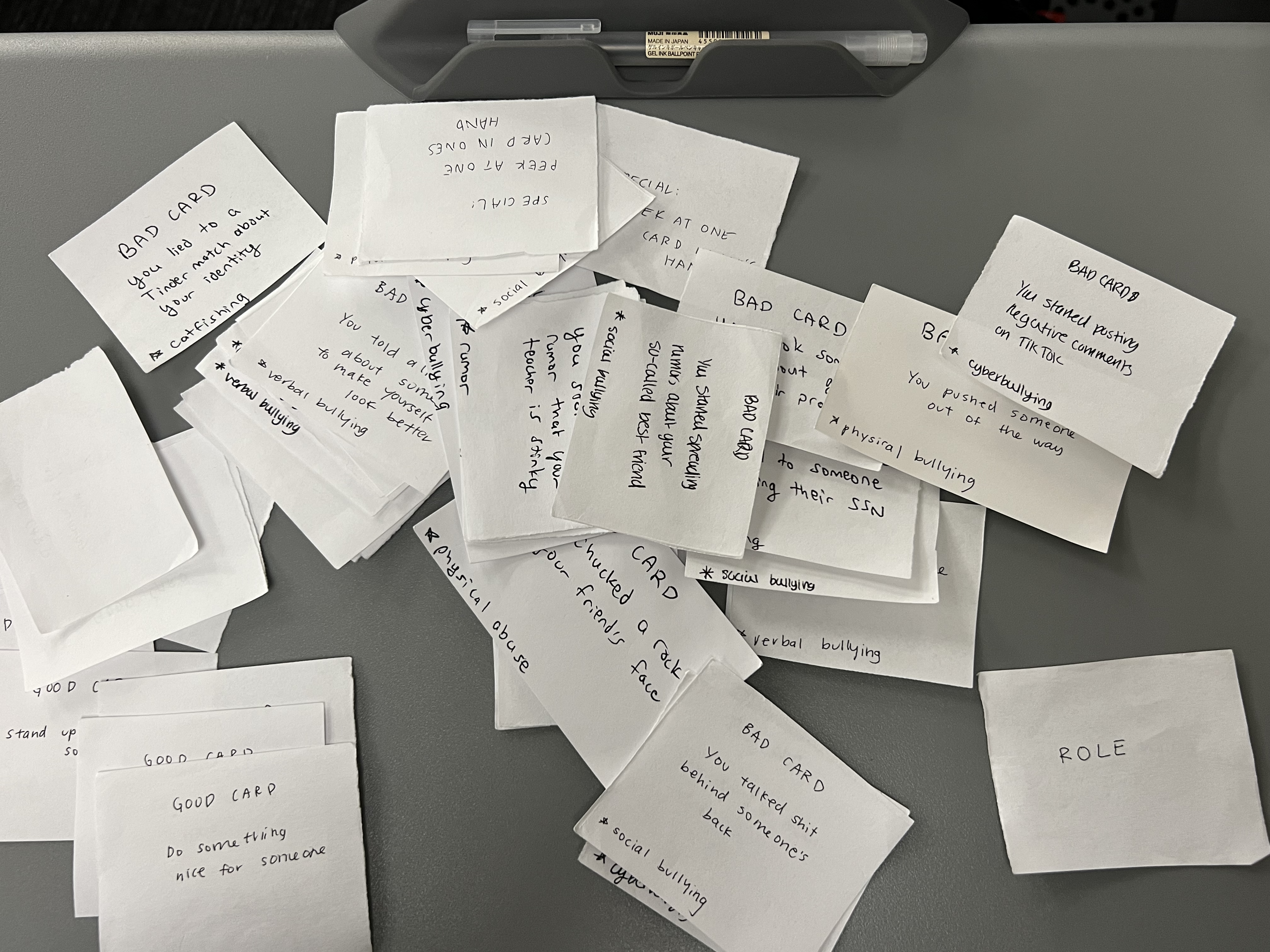
Playtest 2:
-
-
-
- 5 Players:
-
-
- Yazan (20, M)
- Daniela (20, F)
- Genesis (21, F)
- Kenny (20, M)
- Jesus (21, M)
-
-
- Observations:
-
-
- Some confusion on what to play at the beginning
- The bully cards written in 2nd person, vs 3rd, is confusing
- Players weren’t sure where to discard cards
- Laughter around certain bullying situations and how people would stand up against it (i.e. “I would let them take the money, I’m not confrontational”).
- Players still wanted to know who the bullies were even after the game ended
- Players noted it was similar to Among Us
-
-
- Changes made after:
-
-
- We changed all bully action cards to be written in 3rd person, vs 2nd person
- We sectioned out the Rules page for readability and clarity and added a separate voting section
- We updated certain bully action cards to be more serious, to achieve the right tone and mood of the game
-
-
- 5 Players:
-
-
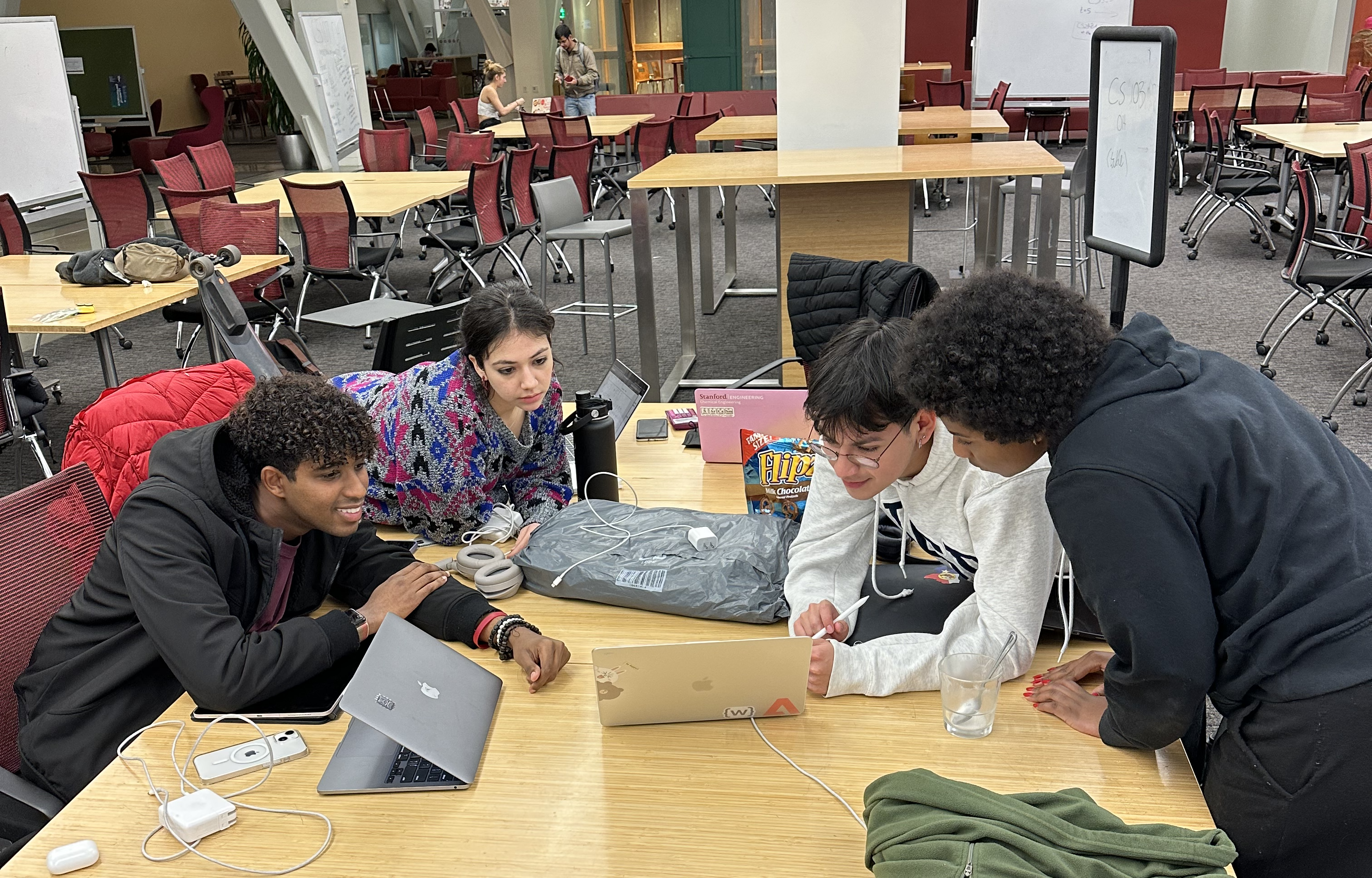
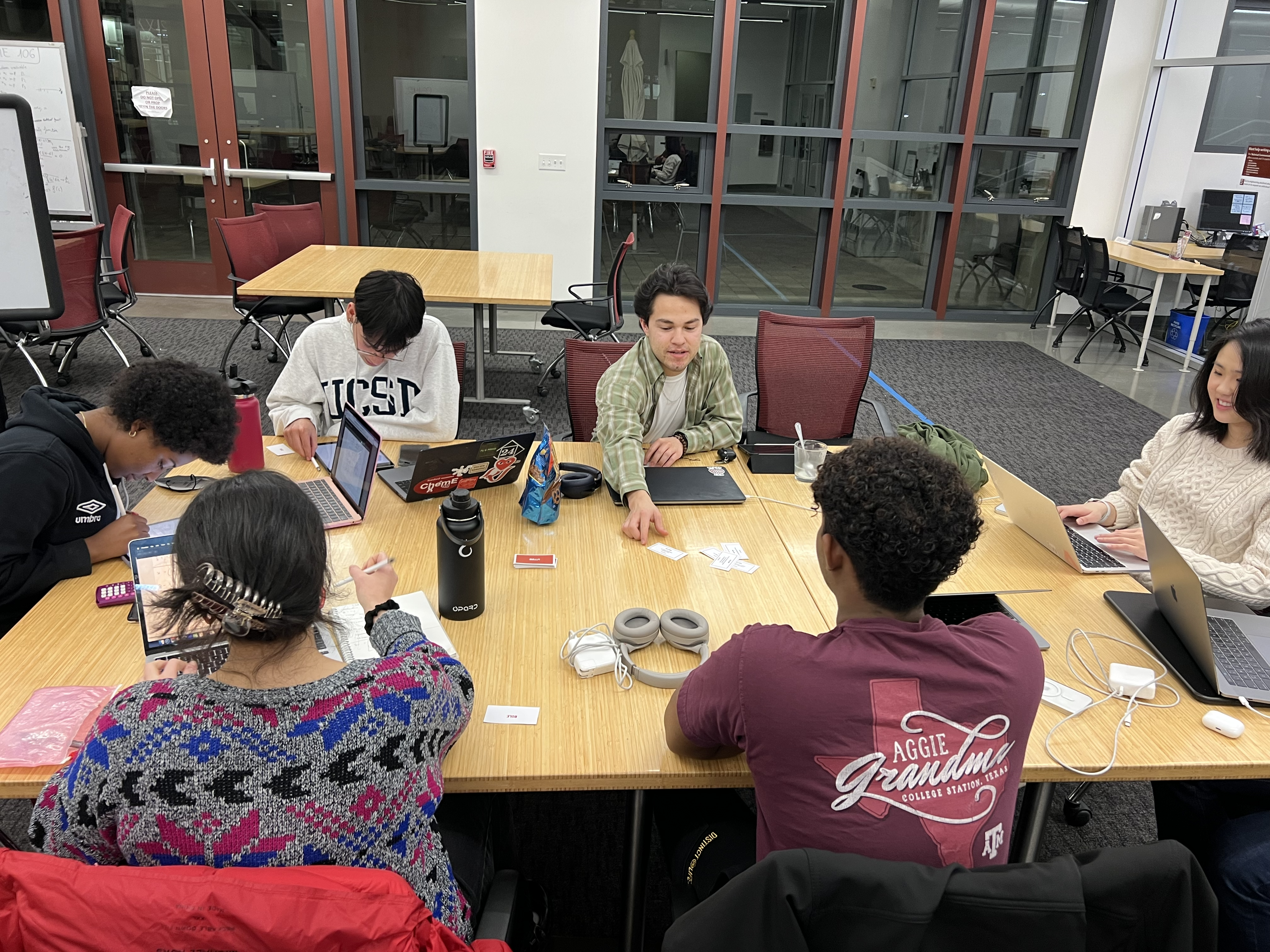
Playtest 3:
-
-
-
- 5 Players:
-
-
- Annie (21, F)
- Marielle (25)
- Alyssa (24, F)
- Yuchen (23, F)
- Nick (24, M)
-
-
- Observations:
-
-
- People discussed their own experiences with bullying
- People enjoyed the special power cards
-
- Perhaps add more ways to initiate voting?
-
- How might we shuffle cards better?
-
- More starting cards for piles?
-
-
-
- 5 Players:
-
-
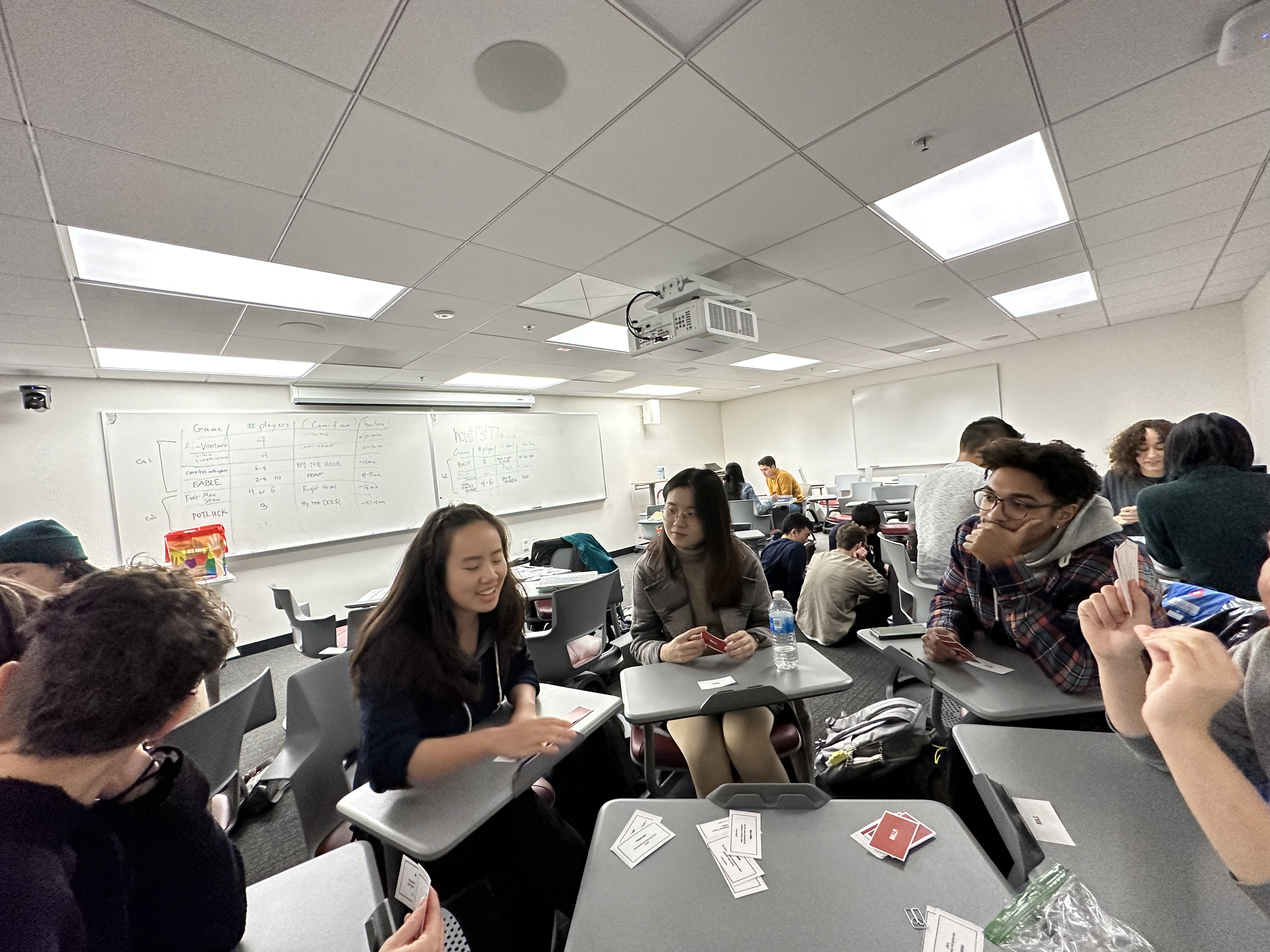
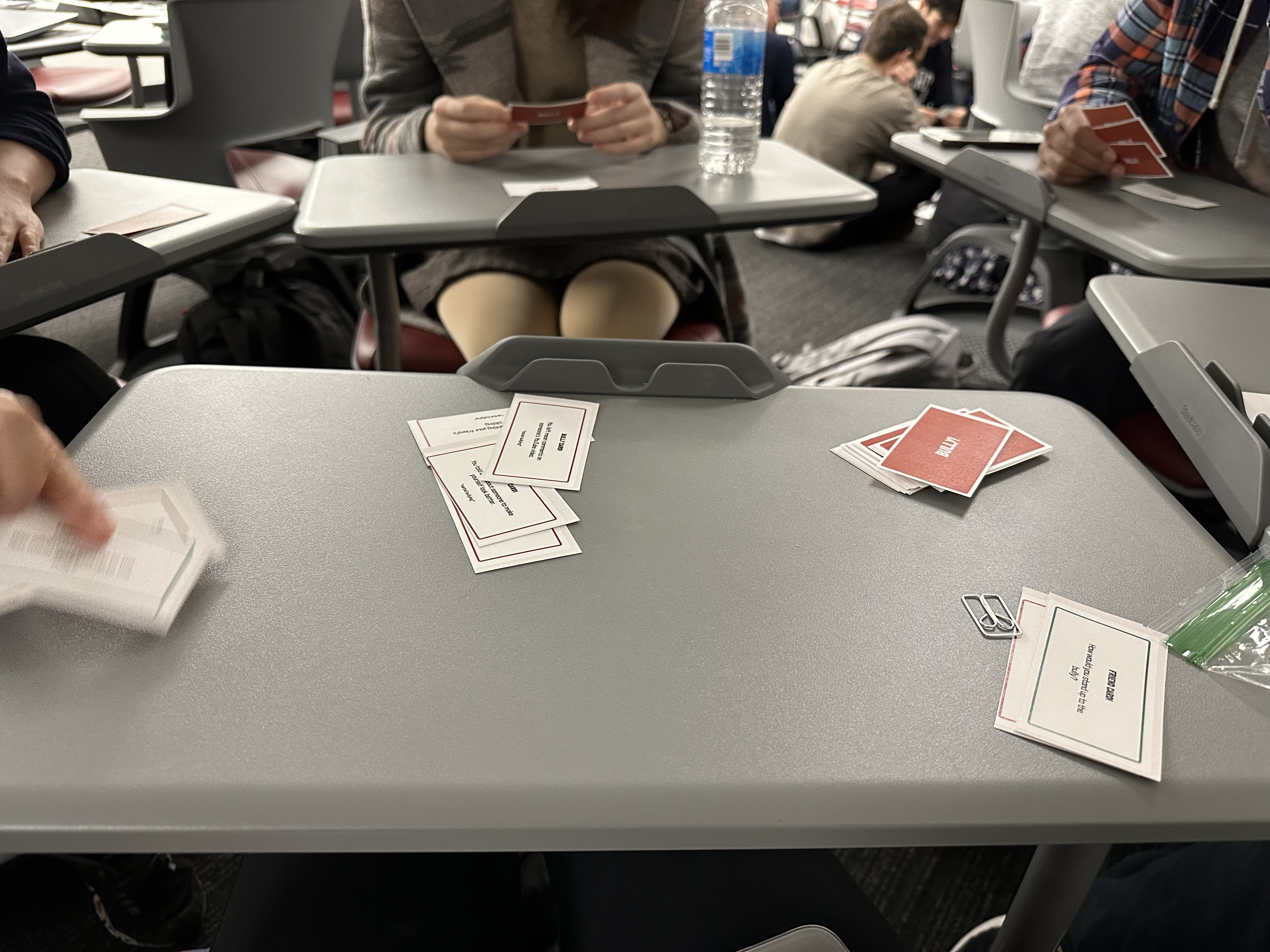
Playtest 4:
-
-
-
- 5 Players:
-
-
- Alejandro (22, M)
- Isabelle (22, F)
- Miranda (21, NB)
- Jasmine (23, NB)
- Yasmine (21, F)
-
-
- Observations:
-
-
- “The special powers cards are a good addition!”
- During the first game, players forgot to discuss who the bullies might be
- First game ended by destroying the bully monster (we’ve now had the game conclude in all possible outcomes!)
-
- Bully: “I should have lied and played a bad card, I gambled wrong.”
-
- Players would poll the crowd with what they should play: “I can either force a vote, or play a bad card.”
- Special powers cards led to more discussions about what cards each player had, forcing lying or exposing players’ roles
-
-
- 5 Players:
-
-
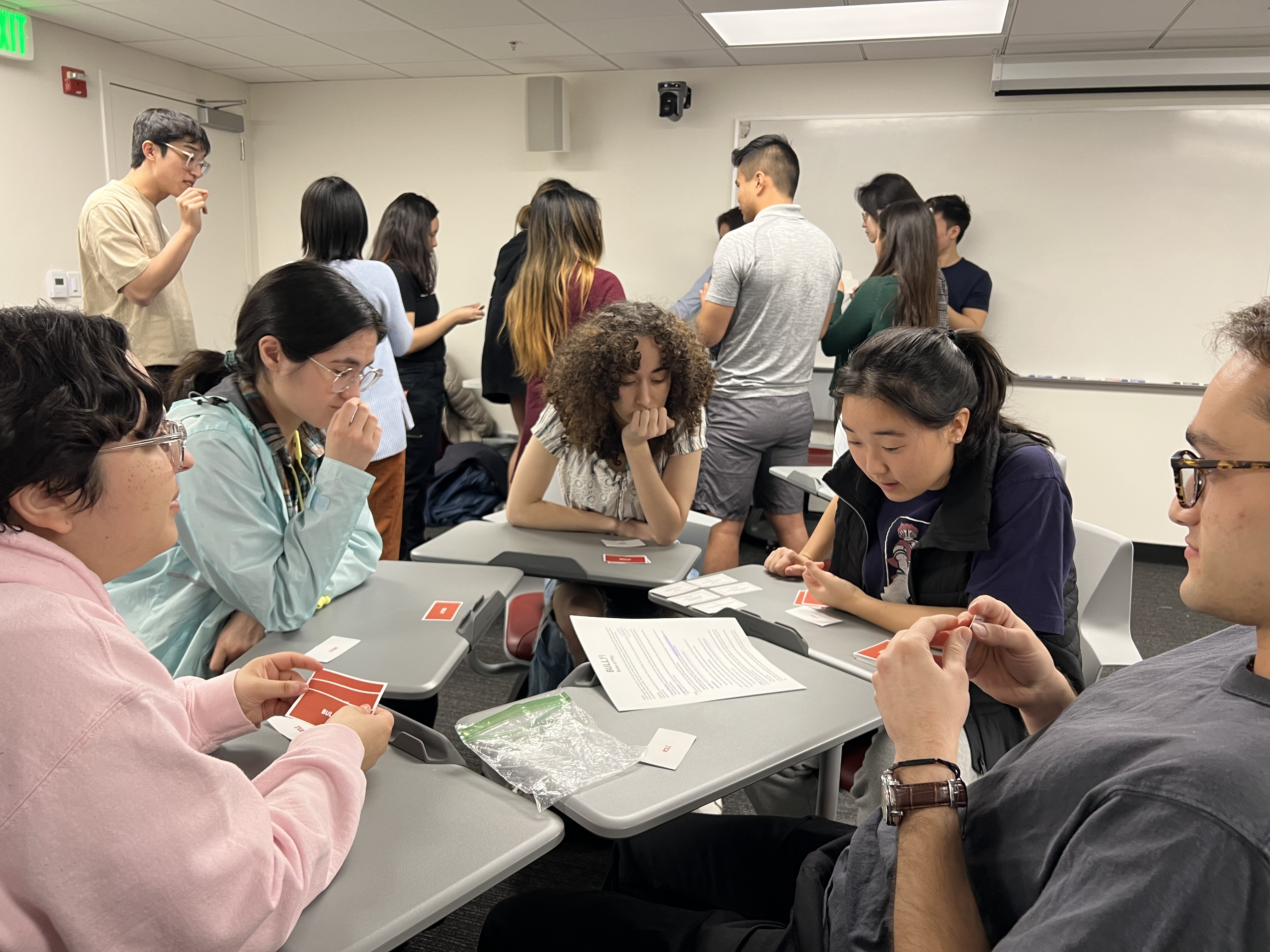
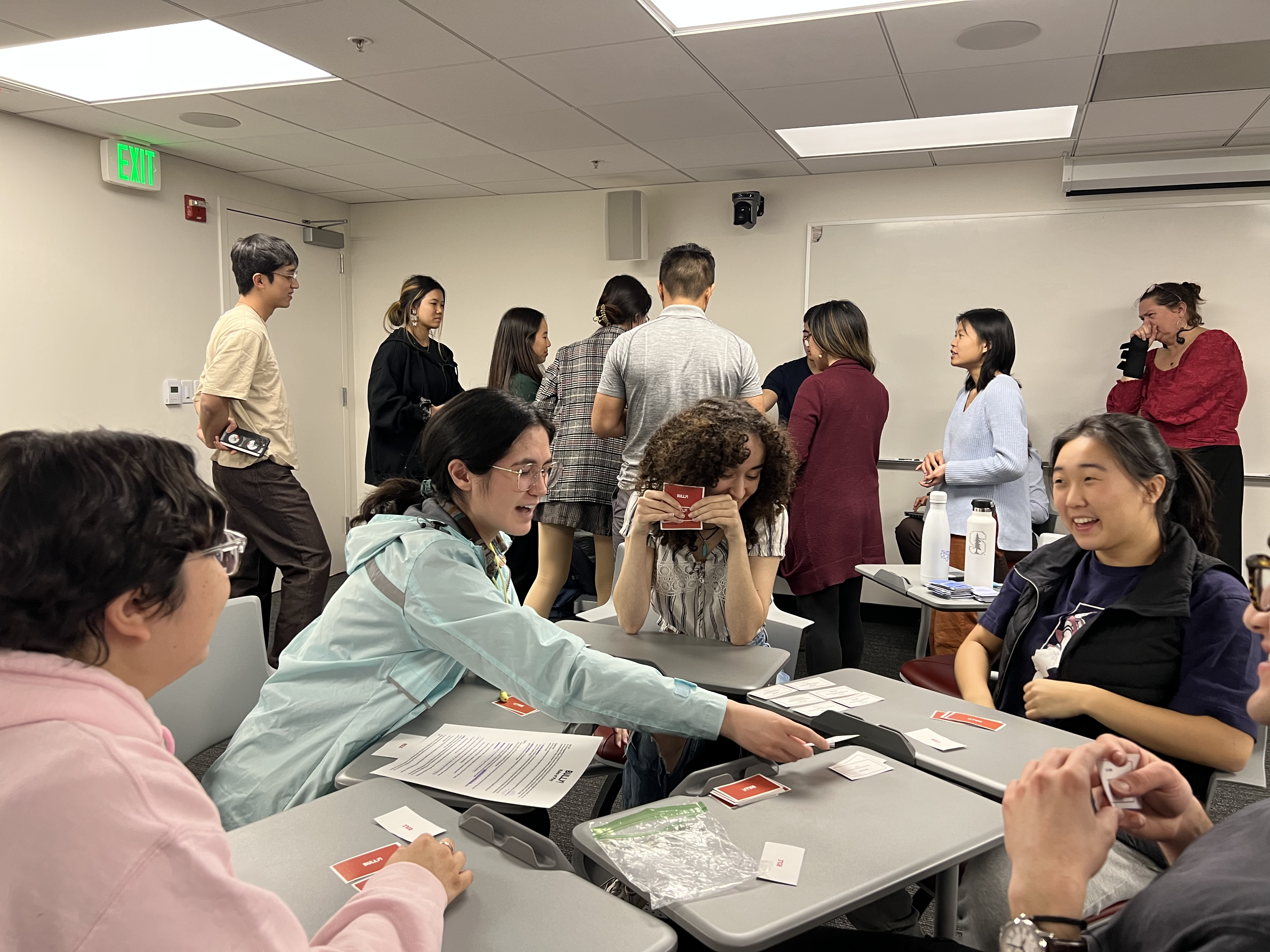
Link to “print at home” PDF:
- BULLY! Printable PDF
- High-quality Figma


